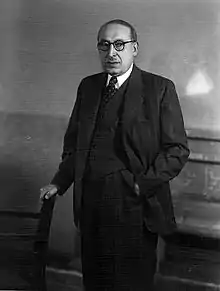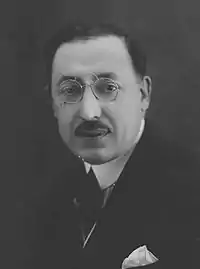Ahmad Qavam
Ahmad Qavam (2 January 1873 – 23 July 1955; Persian: احمد قوام), also known as Qavam os-Saltaneh (Persian: قوام السلطنه), was a politician who served as Prime Minister of Iran five times.
Ahmad Qavam | |
|---|---|
 | |
| 19th Prime Minister of Iran | |
| In office 17 July 1952 – 22 July 1952 | |
| Monarch | Mohammad Reza Pahlavi |
| Preceded by | Mohammed Mosaddeq |
| Succeeded by | Mohammed Mosaddeq |
| In office 28 January 1946 – 18 December 1947 | |
| Monarch | Mohammad Reza Pahlavi |
| Preceded by | Ebrahim Hakimi |
| Succeeded by | Mohammad-Reza Hekmat |
| In office 9 August 1942 – 15 February 1943 | |
| Monarch | Mohammad Reza Pahlavi |
| Preceded by | Ali Soheili |
| Succeeded by | Ali Soheili |
| In office 22 June 1922 – 15 February 1923 | |
| Monarch | Ahmad Shah Qajar |
| Preceded by | Hassan Pirnia |
| Succeeded by | Mostowfi ol-Mamalek |
| In office 4 June 1921 – 21 January 1922 | |
| Monarch | Ahmad Shah Qajar |
| Preceded by | Zia'eddin Tabatabaee |
| Succeeded by | Hassan Pirnia |
| Personal details | |
| Born | 2 January 1873 Tehran, Sublime State of Persia |
| Died | 23 July 1955 (aged 82) Tehran, Imperial State of Iran |
| Resting place | Fatima Masumeh Shrine |
| Political party | Democrat Party |
| Other political affiliations | Reformers' Party (1920s)[1] |
| Spouse(s) | Shazdeh Khanoom (divorced) Zahra Alizadeh (divorced) Zahra Delshad[2] |
| Children | 1[3] |
Early life
Qavam was born in 1873 to a prominent Persian family with origins in Ashtian. His uncle, Amin Aldoleh, was a Prime Minister of Iran. Hasan Vossug, another Prime Minister, was his older brother.[4] Qavam served in the royal court of Nasereddin Shah early in his career and obtained the title os-Saltaneh during the Constitutional Revolution of Iran in 1909. The letter signed by Mozaffaredin Shah in acceptance of the Constitutional Revolution was written by Qavam, who had the title of Dabir-e Hozoor (Private Secretary) at the time. Qavam became Prime Minister several times during both the Qajar and Pahlavi dynasties. Twice he played a significant role in preventing the USSR from annexing Iran's northern provinces.
Political career

Qavam was appointed governor of Khorasan Province in 1918, during which time he responded to the ongoing famine and the Spanish flu pandemic.[5][6] He was a hardliner administrator and banned some of the newspapers which had been published in the region.[7]
In 1921, during the coup d'état of Tehran against the Qajar government, Tabatabaee ordered Colonel Pessian to arrest many of the opposition, among them Ahmad Qavam.
However, with the fall of Tabatabaee's government and the refusal by Mostowfi ol-Mamalek and others to accept the position of Prime Minister due to the unstable political situation, Qavam, just released from the Ishratabad prison of Tehran, was offered the position. He accepted and became Prime Minister in circumstances so unusual that Iraj Mirza wrote the following verses:
یکی را افکند امروز در بند
کند روز دیگر او را خداوند
"One day in prison he is thrown,
another day the King's chair he'll own"
Qavam in fact ordered the arrest of Seyyed Zia'eddin Tabatabaee in an incident 25 years later. He also ordered the crackdown on the revolt of Colonel Pessian which he crushed with the aid of Reza Pahlavi.
Of the major events that occurred during his terms as the Prime Minister, was his invitation to Arthur Millspaugh for assisting the government in its finances. Another was the riots of 1942 for economic hardship. He appointed Sepahbod Ahmad Amir-Ahmadi to restore order and end the riots, which he did forcefully. Qavam was also instrumental in the 1942 Tripartite Treaty between Iran, Russia, and Britain.
He was again voted Prime Minister on 26 January 1946 with a slim margin in the Majlis of 52–51.[8] The Majlis thought he would have the best chance of resolving the Soviet-inspired rebellion of the occupied Azerbaijan province since Qavam was the largest property owner in the region. Qavam did not disappoint. He ordered the Iranian delegation to the UN to negotiate issues pending before the Security Council directly with the Soviet delegation. He then flew to Moscow to discuss the issues personally with Stalin.[9]
When the Soviets violated the terms of the Tripartite Pact which called for all foreign military forces to be withdrawn from Iranian territory by 2 March 1946, it drew a strong rebuke from Parliamentary Whip, Mohammed Mossadegh.
Qavam arranged a deal with the Soviets, granting an oil concession in the North contingent on the approval of the Majlis after the elections. Under the terms of the agreement with Qavam, Soviet troops began withdrawing from Iran. When the new Majlis was seated, they immediately voted against the proposed Soviet oil concession.[10] This earned Qavam the congenial title, "The Old Fox". It also caused significant opposition against him led by Atesh and its editor Mehdi Mir Ashrafi[11] and Mard-i Imruz and its editor Mohammad Masud who publicly argued that Qavam should be killed due to the oil deal with the Soviets.[12]
Death
Qavam died at the age of 82 in 1955 in Tehran. He was survived by his second wife and his only son, Hossein.
See also
References
- Abrahamian, Ervand (1982). Iran Between Two Revolutions. Princeton University Press. p. 121. ISBN 0-691-10134-5.
- روزگار قوام در لاهیجان
- زندگینامه: احمد قوام (1252 - 1334)
- James A. Bill (1988). The Eagle and the Lion. The Tragedy of American-Iranian Relations. New Haven and London: Yale University Press. p. 108. doi:10.12987/9780300159516-006. ISBN 978-0-300-04412-6. S2CID 246116954.
- "Ahmad Qavam". Encyclopaedia Britannica.
- Spinney, Laura (2017). Pale Rider: The Spanish Flu of 1918 and how it Changed the World. London: Vintage. pp. 112–120.
- Hormoz Mehrdad (1980). Political orientations and the style of intergroup leadership interactions: The case of Iranian political parties (PhD thesis). The Ohio State University. p. 186. ISBN 979-8-205-08664-6. ProQuest 303067167.
- "Iran Chooses Premier in 51 to 50 Vote", The Salt Lake Tribune, 27 January 1946, p8; Manuucher Farmānfarmaian and Roxane Farmanfarmaian, Blood and Oil: A Prince's Memoir of Iran, from the Shah to the Ayatollah (Random House, 2005), p. 179
- Samii, Bill (6 May 2005). "World War II -- 60 Years After: The Anglo-Soviet Invasion of Iran And Washington-Tehran Relations". Radio Free Europe. Retrieved 11 November 2012.
- Rubin, Barry (1980). Paved With Good Intentions. Oxford University Press. pp. 33–35. ISBN 0-19-502805-8.
- Laurence Paul Elwell-Sutton (1968). "The Iranian Press, 1941-1947". Iran. 6: 74. doi:10.2307/4299603. JSTOR 4299603.
- Camron Michael Amin (August 2001). "Selling and Saving "Mother Iran": Gender and the Iranian Press in the 1940s". International Journal of Middle East Studies. 33 (3): 337–338. doi:10.1017/S0020743801003014. PMID 18159657. S2CID 6159141.
Other sources
- T'Alí Rizā Awsatí. (2003). Iran in the Past Three Centuries (Irān dar Se Qarn-e Goz̲ashteh), Volumes 1 and 2 (Paktāb Publishing, Tehran, Iran, 2003). ISBN 964-93406-6-1 (Vol. 1), ISBN 964-93406-5-3 (Vol. 2).
- Hamid Shokat. (2006). Dar Tir Rase Hadese, The political life of Qavam osSaltaneh. Tehran, ISBN 9789648897142. Published by akhtaranbook (www.akhtaranbook.com)
External links
 Media related to Ahmad Qavam at Wikimedia Commons
Media related to Ahmad Qavam at Wikimedia Commons